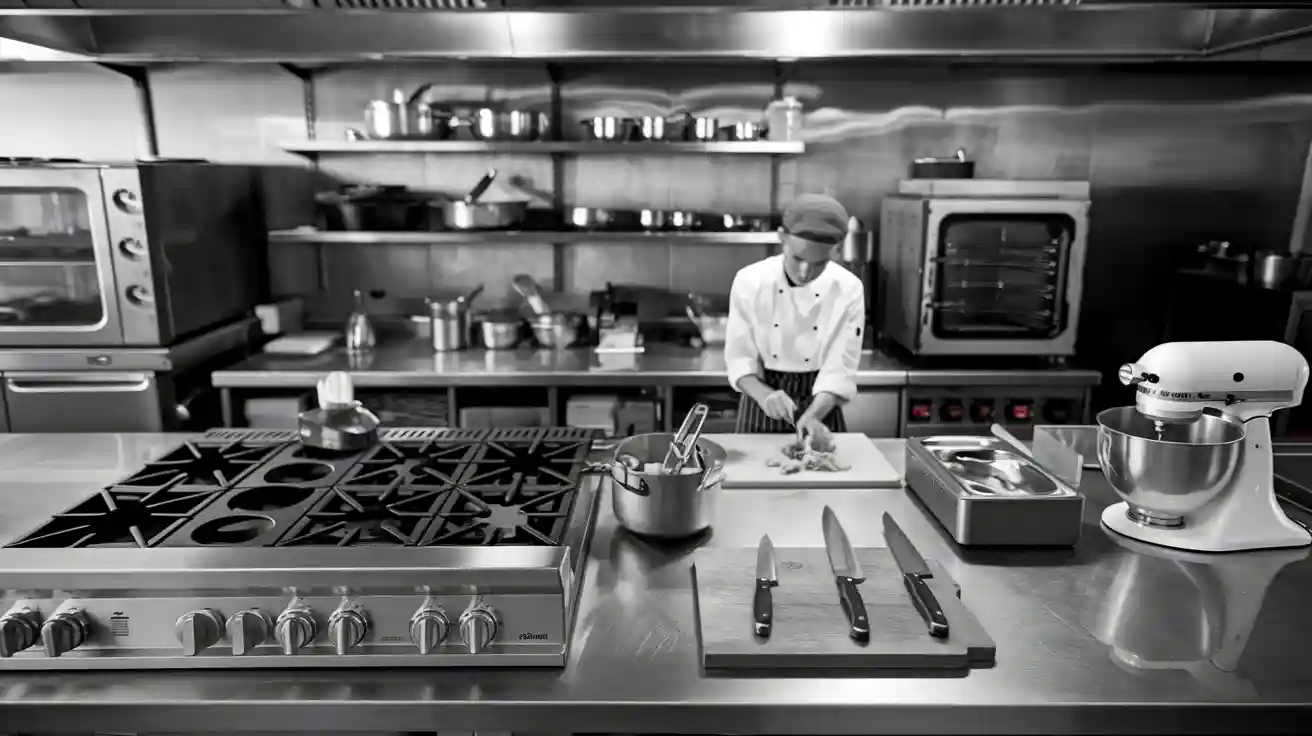
You rely on the right restaurant kitchen equipment to keep your commercial kitchen running smoothly. Investing in commercial cooking equipment improves efficiency, safety, and food quality. The table below shows how restaurant kitchen equipment shapes restaurant success and addresses challenges in the kitchen:
| Aspect | Data / Impact |
|---|---|
| Restaurant Adoption | Over 50% of restaurants upgrade kitchen equipment for faster, reliable service |
| Energy Efficiency | ENERGY STAR units use up to 30% less energy in a commercial kitchen |
| Smart Tech & Automation | IoT and robotics boost restaurant kitchen efficiency and consistency |
Essential Pieces of Restaurant Equipment for Cooking
Commercial Ovens
You need commercial ovens in your restaurant kitchen to bake, roast, and cook many dishes. Ovens stand out as the most important commercial cooking equipment for restaurants. Industry reports show that ovens lead the market because of their versatility and reliability. The global commercial cooking equipment market reached $13.7 billion in 2023 and will likely grow to $18.6 billion by 2034. Ovens, stoves, grills, fryers, and steamers make up the core of restaurant kitchen equipment.
Here is a table showing how much energy different cooking appliances use in a commercial kitchen:
| Appliance Type | Average Daily Electricity Consumption (kWh) | Percentage of Total Kitchen Electricity Use |
|---|---|---|
| Refrigeration | 70 | 41% |
| Fryers | 11 | 13% |
| Combination Ovens | 35 | 12% |
| Bain Maries | 27 | 9% |
| Grills | 37 | 12% |
You can see that ovens and grills use a lot of energy. Good maintenance and smart use help you save on utility costs.
Ranges and Stovetops
Ranges and stovetops let you boil, sauté, simmer, and sear. These pieces of restaurant kitchen equipment give you control over heat and speed. You can prepare soups, sauces, and main dishes quickly. Many restaurants choose gas or electric ranges based on their menu and kitchen setup.
Grills and Griddles
Grills and griddles help you cook burgers, steaks, pancakes, and vegetables. They give food a unique flavor and texture. Grills are common in both quick-service and full-service restaurants. Griddles offer a flat surface for even cooking. Both are essential pieces of restaurant equipment for high-volume kitchens.
Deep Fryers
Deep fryers let you make crispy fries, chicken, and seafood. High-quality fryers cook food evenly and keep oil at the right temperature. Modern fryers have safety features like automatic shutoff and cool-touch handles. Oil filtration systems help you save money and keep food tasting fresh.
- High-quality fryers ensure even cooking and consistent taste.
- Safety features reduce accident risks in a busy kitchen.
- Programmable controls and quick recovery times boost efficiency.
Ventilation Hoods
Ventilation hoods remove smoke, steam, and odors from your commercial kitchen. They keep the air clean and help you meet safety codes. Good ventilation protects your staff and keeps your restaurant kitchen comfortable.
Tip: Clean your ventilation hoods often to prevent grease buildup and fire hazards.
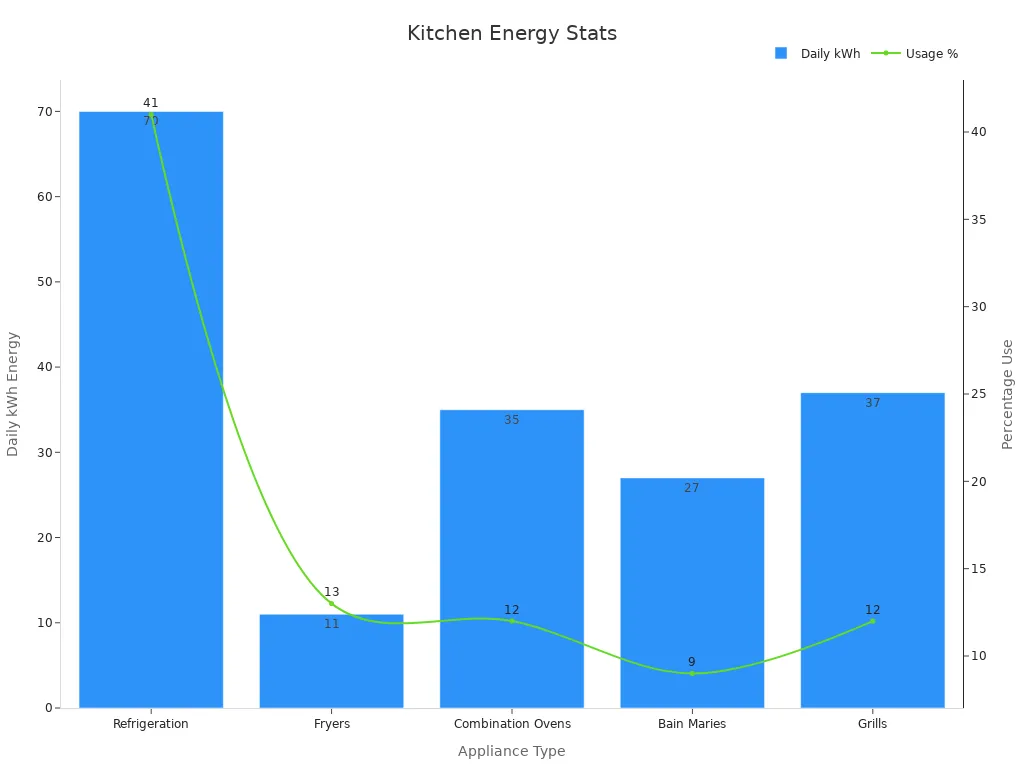
Commercial Kitchen Equipment for Refrigeration and Storage
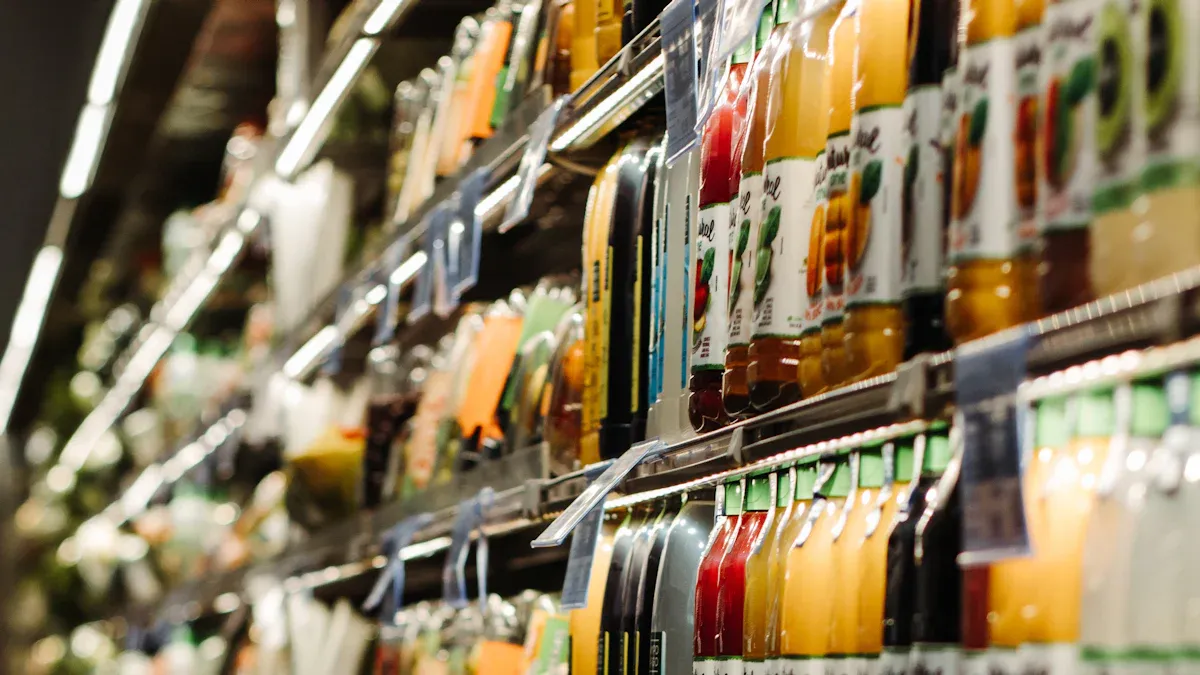
Commercial Refrigerators
You need reliable commercial refrigerators to keep food fresh and safe in your restaurant kitchen. These units help you store ingredients at the right temperature, which prevents spoilage and supports food safety. The commercial kitchen equipment market shows that refrigerators and freezers make up the largest product segment, holding over 22% of revenue share in 2022. Most restaurants choose self-contained systems for easy installation and low maintenance. Smart refrigerators with IoT features let you monitor temperatures and receive alerts, which improves reliability and reduces food waste. The market for commercial refrigerators reached $6.08 billion in 2024 and is expected to grow to $11.36 billion by 2033.
Here is a table showing key market insights:
| Aspect | Details |
|---|---|
| Market Valuation (2024) | USD 6.08 Billion |
| Projected Market Size (2033) | USD 11.36 Billion |
| Restaurant Kitchen Market Share | Approximately 50% |
| Product Types Market Share | Reach-in refrigerators ~45%, Undercounter ~35%, Walk-in coolers ~20% |
| Reliability Insights | IoT-enabled smart refrigerators allow remote temperature monitoring and maintenance alerts |
Freezers and Walk-In Coolers
Freezers and walk-in coolers give you extra space for bulk storage in your restaurant. You can store large quantities of meat, seafood, and frozen goods. Walk-in coolers help you organize ingredients and keep them at safe temperatures. Remotely operated units reduce heat and noise in the kitchen, which makes your workspace more comfortable. Many restaurants now use eco-friendly refrigerants to lower their environmental impact and meet new regulations.
Shelving and Storage Racks
Shelving and storage racks help you organize your kitchen and make the most of your space. You can keep dry goods, canned foods, and supplies off the floor. This setup improves air circulation and makes cleaning easier. Stainless steel racks resist rust and last longer, which supports food safety in your restaurant kitchen.
Workstations
Workstations give your staff a place to prep, assemble, and portion food. You can set up worktables near refrigeration and storage areas to speed up your workflow. Many restaurants use stainless steel workstations because they are easy to clean and sanitize. Organized workstations help you keep your commercial kitchen running smoothly and reduce mistakes during busy hours.
Tip: Place shelving and workstations close to your refrigeration and storage units. This setup saves time and keeps your kitchen efficient.
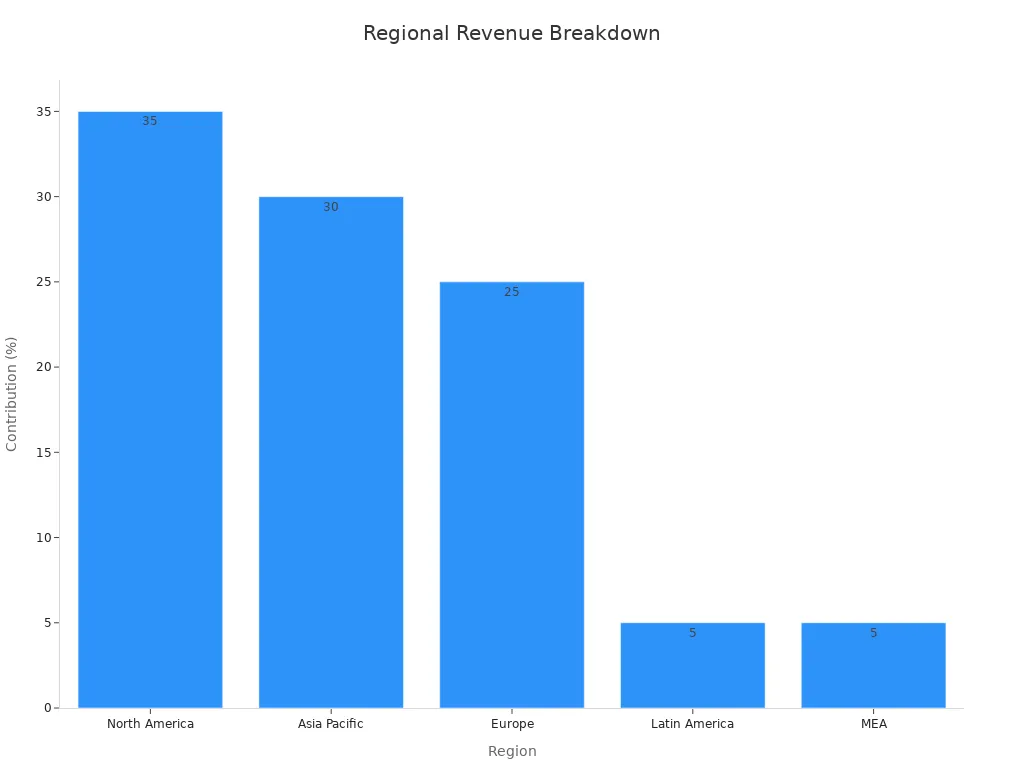
Essential Restaurant Equipment for Food Preparation
Commercial Mixers
You need commercial mixers in your restaurant kitchen to handle dough, batters, and sauces. These mixers stand out as essential restaurant equipment because they keep your kitchen running during busy hours. You can rely on their durability and quality, which means fewer breakdowns and less downtime. Energy-efficient models help you save on utility costs and support sustainable practices. Many mixers come with programmable settings, so you get consistent results and reduce mistakes. Easy maintenance keeps your food prep supplies clean and your kitchen safe.
Food Processors
Food processors help you chop, slice, and puree ingredients quickly. You can use this food preparation equipment to save time and boost productivity in your restaurant. High-quality processors match your kitchen’s output needs and prevent service delays. You can count on their reliability, which is important for busy commercial kitchens. Regular maintenance and self-cleaning features extend their lifespan and keep your food prep supplies ready for daily use.
Slicers and Choppers
Slicers and choppers let you prepare meats, cheeses, and vegetables with speed and precision. You can choose models that fit your restaurant’s menu and volume. Reliable food preparation equipment reduces the risk of malfunctions and keeps your kitchen efficient. Customer feedback and brand reputation help you pick slicers that last for years in a high-demand restaurant kitchen.
Blenders
Blenders are vital for smoothies, soups, and sauces in any restaurant. High-performance blenders with motors above 1000W handle tough ingredients like nuts and seeds. You get consistent results and fast blending, which is important for high-volume kitchens. Quiet blenders help you maintain a pleasant atmosphere for staff and guests. Easy-to-clean designs and strong warranties add value to your food prep supplies.
Kitchen Utensils and Smallwares
You need a full set of kitchen utensils and smallwares to support every step of food preparation. These include knives, spatulas, mixing bowls, and measuring cups. Durable utensils last longer and help you avoid frequent replacements. Keeping your food prep supplies organized improves workflow and food safety in your restaurant kitchen.
Tip: Choose food preparation equipment with self-cleaning or easy-maintenance features. This keeps your restaurant kitchen safe and efficient.
Restaurant Kitchen Equipment for Cleaning and Sanitation
Commercial Dishwashers
You need commercial dishwashers to keep your restaurant kitchen running smoothly. These machines clean dishes quickly and help you meet strict hygiene standards. The National Restaurant Association reports that 72% of diners care about cleanliness when choosing where to eat. During busy hours, a full-service restaurant can create up to 100 dirty dishes every hour. Commercial dishwashers use high-temperature cycles, reaching 150°F for washing and 180°F for sanitizing. This process kills harmful bacteria and keeps your kitchen safe. Many restaurant owners now invest in smart dishwashers to save water and energy. Water-efficient models use about 12 gallons per cycle and offer sensor-activated wash cycles.
| Statistic / Insight | Description | Source |
|---|---|---|
| 72% of restaurant patrons consider cleanliness a major factor | Cleanliness drives demand for commercial dishwashers | NRA 2023 survey |
| 100 dirty dishes per hour during peak times | Shows high dishwashing needs in restaurants | NRA 2023 report |
| High-temp cycles (150°F wash, 180°F rinse) | Ensures superior hygiene | Industry analysis |
Note: About 48 million people in the U.S. get foodborne illnesses each year. Using commercial dishwashers helps prevent contamination in your restaurant kitchen.
Sinks and Faucets
You rely on sinks and faucets for daily cleaning tasks in your restaurant kitchen. Three-compartment sinks let you wash, rinse, and sanitize pots, pans, and utensils. Durable faucets with sprayers make it easy to remove food debris. Proper sink setup supports food safety and helps you follow health codes. Many kitchens use touchless faucets to reduce the spread of germs.
Handwashing Stations
Handwashing stations are essential for every restaurant kitchen. You must place them in easy-to-reach spots so staff can wash hands before handling food. These stations include soap dispensers, paper towels, and clear signage. Touchless dispensers and sinks help lower the risk of cross-contamination. Regular handwashing keeps your kitchen safe and supports public health.
Safety and Sanitation Equipment
You need cleaning and sanitation equipment to protect your restaurant kitchen from hazards. This includes certified food-safe wipes, brushes, and sponges for deep cleaning. Organized dispensing systems, like touchless dispensers, help prevent cross-contamination. Staff training and regular audits keep your kitchen up to code.
- Food safety laws require you to separate raw and cooked foods.
- HACCP plans help you monitor critical points in your kitchen.
- Regular audits and a strong safety culture keep your restaurant compliant.
Industry reports show that restaurants lead the market for professional cleaning services because of strict health rules and frequent food preparation. Using eco-friendly products and digital tools helps you meet regulations and improve efficiency.
Supporting Commercial Cooking Equipment and Technology
Point of Sale (POS) Systems
You need a reliable Point of Sale (POS) system to keep your restaurant running smoothly. Modern POS systems like Lavu offer 99.99% uptime, so you rarely face service interruptions. You can track sales in real time and make quick decisions about promotions, inventory, and staffing. These systems help you avoid delays in sales reporting, which can hurt your ordering and profitability. With features like low-stock alerts and automatic item unavailability, you manage your commercial kitchen equipment and supplies more efficiently. POS systems also collect detailed data on sales, customers, and payments. You use this information to spot trends, adjust your menu, and improve marketing. Many restaurant owners say that advanced POS systems improve order accuracy and speed up service.
Tip: Use POS analytics to set goals and track your restaurant’s performance over time.
Kitchen Display Systems
Kitchen Display Systems (KDS) help your restaurant kitchen stay organized and efficient. You replace paper tickets with digital screens, which cuts waste and saves money. KDS shows orders instantly, so your staff can prioritize tasks and reduce mistakes. Many restaurants report faster service and fewer errors after switching to KDS. For example, a national burger chain used KDS to speed up orders, while a Chicago pizzeria managed rush hours better. Industry data shows that 76% of restaurant operators believe technology gives them an edge, and 73% have seen higher productivity since investing in new systems. KDS also helps you adjust staffing and improve communication in your kitchen.
- KDS reduces paper waste and supports eco-friendly practices.
- You improve order accuracy and keep your commercial kitchen running smoothly.
Display and Holding Equipment
Display and holding equipment keeps your food at the right temperature before serving. You use heated cabinets, display cases, and warmers to hold cooked items safely. This equipment is essential for busy restaurants that need to serve food quickly and maintain quality. You can choose models that fit your menu and kitchen layout. Proper display and holding equipment helps you meet food safety standards and keeps your customers happy. When you invest in the right commercial kitchen equipment, you improve both efficiency and food quality in your restaurant.
How to Choose the Right Commercial Kitchen Equipment
Choosing the right items from your restaurant equipment list shapes your kitchen’s efficiency, safety, and profitability. You need to consider your space, menu, budget, energy use, and supplier reliability. This section guides you through each step so you can build a smart kitchen equipment list and a reliable restaurant equipment checklist.
Assessing Kitchen Size and Layout
Start by measuring your kitchen space. Use precise tools or software to map out your kitchen layout. Studies show that accurate measurements help you place equipment for both safety and efficiency.
- Experts use AutoCAD drawings and standard appliance dimensions to plan kitchens.
- Focus on the “food safety triangle”: the sink, countertop, and stove. Keep these close together to reduce cross-contamination risks.
- The distance between the sink and countertop matters for food hygiene. Shorter distances lower the chance of spreading germs.
- Place refrigerators, sinks, and stoves in a way that supports safe and fast movement.
Tip: Prioritize food safety in your kitchen layout. Place sinks near prep areas and keep walkways clear.
A well-organized kitchen supports faster service and better food quality. High-capacity refrigerators with easy-to-clean surfaces help you keep ingredients fresh and safe. Stainless steel prep tables near cold storage reduce unnecessary movement and speed up food prep. Good kitchen organization makes your restaurant equipment checklist more effective.
Matching Equipment to Your Menu
Your menu decides what you need on your commercial kitchen equipment list. Each restaurant type has unique needs.
Here is a table to help you match equipment to your menu:
| Restaurant Type | Key Equipment Needs | Menu and Equipment Match | Extra Factors |
|---|---|---|---|
| Chinese Restaurant | Gas stoves, woks, steamers | Stir-frying, high-flame cooking | Needs strong ventilation |
| Western Restaurant | Ovens, griddles, frying pans | Grilling, baking, frying | Good for steaks, bread, pastries |
| Fast Food Restaurant | High-efficiency fryers, warming cabinets | Quick cooking, high volume | Focus on speed and consistency |
| Specialty Restaurant | Custom equipment for unique dishes | Tailored to menu items | May need multi-functional equipment |
| Small Kitchens | Multi-functional, integrated equipment | Combines frying, boiling, steaming | Saves space, boosts efficiency |
Choose items from your kitchen equipment list that fit your menu. For example, a bakery needs dough mixers and convection ovens, while a sushi bar needs rice cookers and refrigerated prep tables. Avoid buying equipment you will not use. This keeps your restaurant equipment checklist focused and cost-effective.
Budget and Cost Considerations
Set your budget before you start purchasing restaurant equipment. Costs vary based on kitchen size, equipment features, and energy efficiency. Larger kitchens need more or bigger equipment, which increases costs. Energy-efficient models cost more upfront but save money over time.
Here is a table showing typical price ranges for common items on a restaurant equipment list:
| Equipment Category | Typical Price Range (USD) |
|---|---|
| Salamander Broiler | $800 – $3,000 |
| Pasta Cooker | $400 – $1,500 |
| Rice Cooker | $200 – $800 |
| Walk-in Cooler | $5,000 – $20,000 |
| Reach-in Refrigerator | $1,500 – $5,000 |
| Reach-in Freezer | $2,000 – $6,000 |
| Under-counter Refrigerator | $800 – $2,500 |
| Ice Machine | $1,000 – $4,000 |
| Blast Chiller | $3,000 – $10,000 |
| Food Processor | $200 – $1,000 |
| Commercial Mixer | $300 – $2,000 |
| Meat Slicer | $400 – $1,500 |
| Dough Sheeter | $1,000 – $3,000 |
| Vegetable Prep Table | $500 – $1,500 |
| Dry Storage Shelving | $100 – $500 |
| Storage Racks | $200 – $800 |
| Food Storage Containers | $20 – $200 |
| Sheet Pan Racks | $100 – $400 |
| Commercial Dishwasher | $2,000 – $10,000 |
| Three-compartment Sink | $500 – $2,000 |
| Dish Storage Racks | $50 – $300 |
| Pots and Pans | $50 – $500 |
| Baking Sheets and Trays | $20 – $200 |
| Measuring Cups and Spoons | $10 – $50 |
| Knife Sets | $100 – $500 |
| Fire Suppression System | $1,000 – $5,000 |
| First Aid Kit | $20 – $100 |
| Handwashing Stations | $200 – $1,000 |
| Cleaning Supplies | $50 – $200 |
| POS System | $1,000 – $5,000 |
| Kitchen Display System (KDS) | $500 – $2,000 |
| Uniforms and Aprons | $20 – $100 |
| Waste Disposal System | $200 – $1,000 |
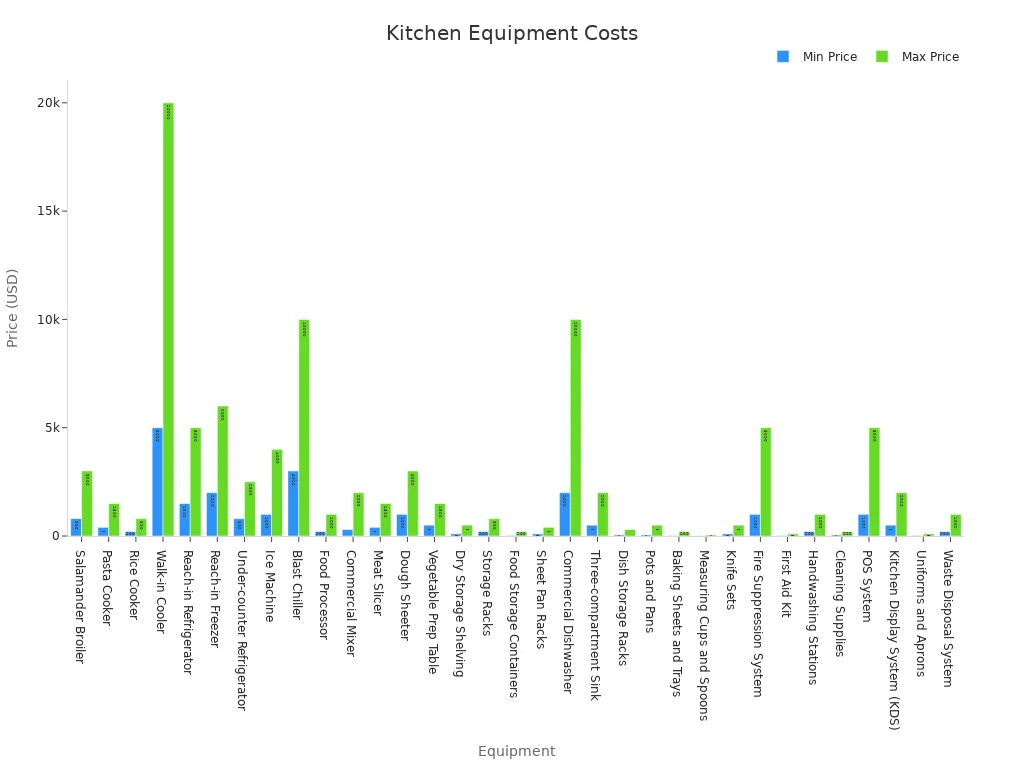
Remember to include shipping, installation, and permits in your budget. Plan for unexpected expenses. A complete restaurant equipment checklist helps you avoid missing key items and keeps your spending on track.
Energy Efficiency and Sustainability
Energy-efficient equipment lowers your utility bills and supports sustainability. Many restaurants now use Energy Star-certified appliances to cut costs and reduce their environmental impact.
- Energy audits help you track how much power your kitchen uses.
- Smart meters and software let you compare the energy use of each appliance.
- Preventive maintenance keeps equipment running at peak efficiency.
- Place refrigerators away from heat sources and set them to the right temperature.
- Switch to LED lighting and use motion sensors to save even more energy.
The National Restaurant Association reports that less than half of restaurants use Energy Star refrigerators, and only 25% use Energy Star dishwashers. Upgrading old appliances can cut energy use by up to 30%. Panda Express uses cloud-connected equipment to monitor energy and water use in real time, which helps them save resources across many locations. Shari’s Cafe & Pies reduced water use by 35% by switching to demand-based systems.
Restaurants use about 38 kWh of electricity and 111 cubic feet of natural gas per square foot. Most of this goes to water heating, refrigeration, and space heating. Investing in energy-efficient items from your kitchen equipment list pays off over time.
Evaluating Suppliers and Warranties
Choose suppliers with strong track records. Check their on-time delivery rates, customer satisfaction scores, and financial stability.
- Ask for references from other restaurant owners.
- Look for quality control certifications like ISO 9001.
- Review financial health to make sure the supplier can support you long-term.
- Check performance metrics such as defect rates and warranty claims.
- Choose suppliers with third-party certifications and positive independent reviews.
- Make sure they offer clear warranty terms and fast support for repairs.
- Consider suppliers who show social and environmental responsibility.
Note: Reliable suppliers help you avoid delays and costly breakdowns. Good warranties protect your investment and keep your kitchen running.
A strong supplier relationship ensures you get the right items for your restaurant equipment checklist. This helps you maintain high standards for food safety, speed, and quality.
You set your restaurant up for success when you invest in the right restaurant equipment list. High-quality equipment from trusted suppliers lasts longer and keeps your restaurant running smoothly. Regular maintenance lowers repair costs and extends equipment life. Start with a clear restaurant equipment list and focus on what your restaurant truly needs.
FAQ
What is the most important commercial kitchen equipment for a new restaurant?
You need reliable ovens, refrigerators, and prep tables. These items help you cook, store, and prepare food safely and efficiently.
How often should you maintain your restaurant equipment?
You should check and clean your equipment every day. Schedule professional maintenance at least twice a year to prevent breakdowns.
Do you need special equipment for serving and presentation equipment?
You need serving and presentation equipment to keep food hot or cold and to display dishes attractively. This equipment helps you impress your customers.


